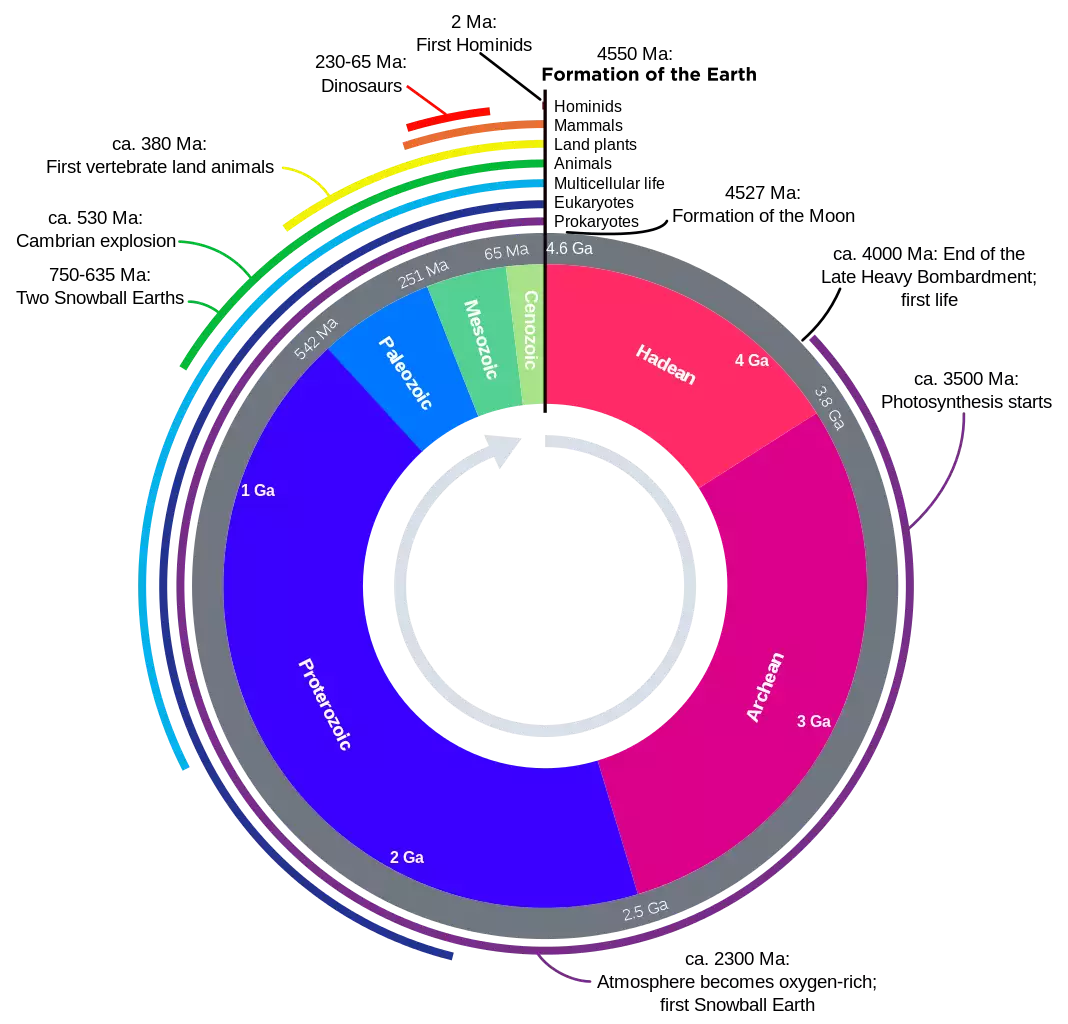The Geology of North America
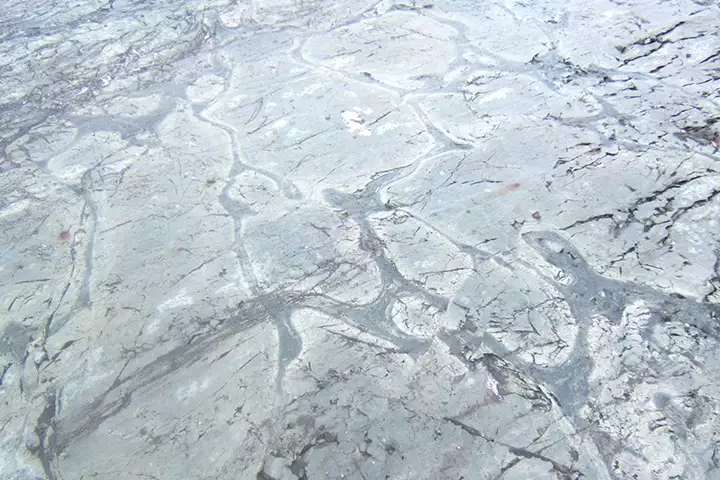
Weathered pillow lava in the Temagami Greenstone Belt of the Canadian Shield
Dated at 2.7 billion years old
As the science of geology has progressed, so has our understanding of the Earth and how it came to be as it is. The amount of observational data available has exploded over the last 50 years but that has served mostly to expand on theories postulated previously. That said, the previous theories have been expanded through the study of the data and more and more intricate elements in the story have been exposed and come clear. At a time when human impact on the planet appears to be causing yet another massive global extinction event, it would be good if more people were exposed to the basics of it.
Classic creation stories aside, geologists estimate the present age of the Earth at 4.5 billion years old, give or take a few million years. During that time a lot of things have changed... and are still changing. Theories abound as to what happened (and how it happened) way back when and, as usual, the nearer to us the object of our study is, the clearer are the lessons contained. In the case of Planet Earth, some of the hard lessons began more than 4 billion years ago: geologists have discovered zircons on the surface of Australia that have been dated using radiometric processes to be about 4.4 billion years old. Other rocks from the Isua Greenstone Belt in Greenland have been dated at 3.8 billion years old. In those days the planet was just barely formed as a discernible rotating ball and the Late Heavy Bombardment was just barely underway (the Late Heavy Bombardment is defined as a large spike in the rate of asteroidal impacts with the interior planets of the Solar System, possibly caused by the movements and orbital adjustments of the larger gas giants).
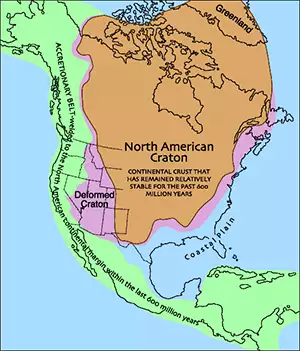
Laurentia-North American Craton
The purple areas were deformed in previous continental collisions
The green area results from the on-going collision of Laurentia with the Pacific plate and with South America
Since men returned from the Moon with lunar rock souvenirs, it has been postulated that the Moon itself was originally part of the disk of the earth until that disk was impacted by another large body and the material of the Moon broken off and ejected into orbit around the Earth. Radiometric dating has suggested a date of 4.533 billion years ago for this to have happened.
An interesting note: the vast majority of water on Planet Earth was created more than a million years before the birth of our Sun. That water was deposited on the planet through the impacts of millions of ice-carrying meteorites, asteroids and comets over the last 4.5 billion years.
Plate tectonics has suggested that the original swirling ball of gases and rocks that eventually became Earth contained some materials that hardened early in the process and may still be present in the center of what are now called "cratons." Cratons form the heart of continental plates and they seem to survive as long as they retain sufficient area, mass and density to continue floating on the liquid mantle below. Most of the planet's great mining districts are centered in the heart of a craton as that is also where the geological conditions occurred for the accumulation of mineral deposits. The cratons we see today have been heavily eroded over the eons and the mineral bodies that were once deep in their hearts are now relatively exposed to the surface.
As the bodies of those cratons are still floating atop the planet's inner mantle, they appear to come together and form a supercontinent about every 450 million years or so, beginning around 3 billion years ago. Supercontinents interfere with the general flow of materials in the Earth's core and mantle and eventually, those massive bits of land are broken up by volcanic activity that usually occurs along the joints where the cratons meet. Supercontinents also interfere with global atmospheric processes and have served to promote global glaciation, the "oxygen catastrophe," global desertification and other elements we humans would consider catastrophic as it would interfere radically with the daily enjoyment of our lives... and though we've only been here but the blink of an eye we're already causing catastrophe on a global scale with many of the things we do on a daily basis to promote our enjoyment of our lives.
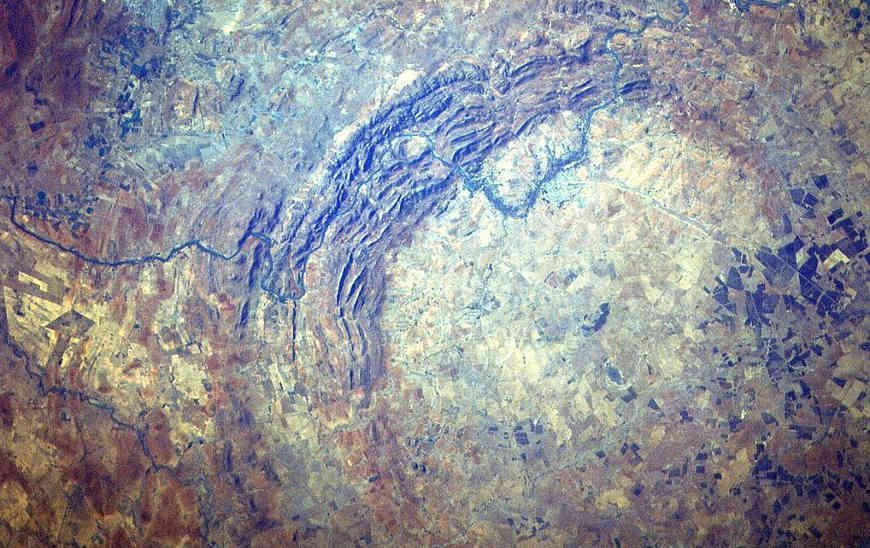
The Vredefort impact crater, the largest visible impact crater on Earth, dated at 2.023 billion years ago
Note the multiple impact rings
Past Supercontinents:
As the oldest material found so far on a sea floor is maybe 170 million years old and the oldest material found on the land surface dates to more than 4 billion years old, geologists have always paid more attention to the record baked into the land. That said, virtually everything ever found on the surface of the planet was at time or another underwater: even the upper levels of Mount Everest are composed of layers of sedimentary rock, some of which display fossils of ancient sea shells.
As the story of geologic history and discovery involves many places around the globe and this website is more focused on North America and the United States, our exposition here will mostly focus on those places in North America where it might be possible to see and touch the minerals and fossils that are the physical evidence on which the story is based.
Caveat: This is a brand new section of this website, required by my efforts to educate my kids in a holistic manner about the history of the Earth by hiking them through various landscapes in the western United States. Before I get too much further into it I might have to add a section to the website discussing the various indigenous people who lived in North America before the disastrous (for them) invasion by the Europeans as we live in New Mexico, surrounded by people with oral histories that reach back thousands of years. Like the rest of this website, it's all going to take a while to fill out...
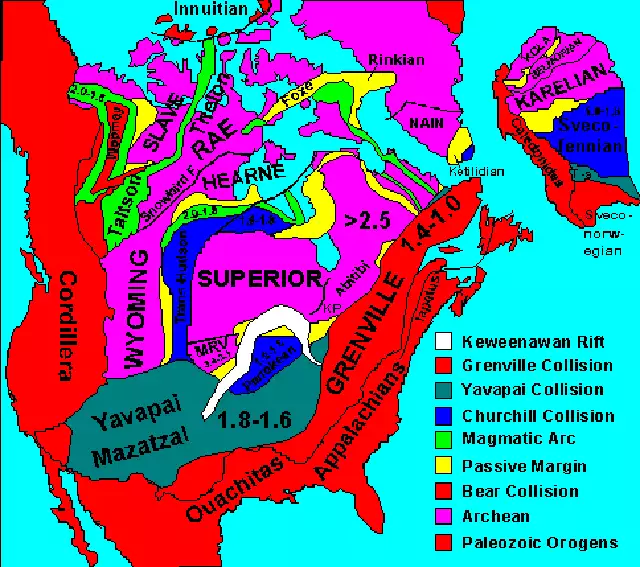
The basement rocks of North America
Numbers mean billions of years ago
So then, a chart of time that will eventually offer links to more data about each time period, and keep in mind that each of the "differentiations" in time below are also often further divided into period, events, ages... Some things I can't put on the chart, like the 200-million-year-old-and-still-going collision with the Farallon Plate. That collision began when the area that is now Utah was seafront property and what has accreted onto the land mass that is now North America since that time was scraped off the surface of the Farallon plate as it was subducted beneath the North America Plate. That ongoing collision and subduction have caused the Rocky Mountains, the Basin and Range Province, the Sevier Orogeny, the Laramide Orogeny, the Nevadan Orogeny and more.
The Cenozoic Era - The Age of Mammals
Quaternary Period
Present-2 million years ago
The explosion of Man. The most recent Ice Ages
Neogene Period
2-23 million years ago
North America crashes into South America
Mountain Building
23-26 million years ago
Vulcanism and mountain building in western North America: the modern Rockies are built
Paleogene Period
23-63 million years ago
Explosion of Mammals. Continued subduction of Farallon plate on West Coast, Basin & Range Province built
The Mesozoic Era - The Age of Reptiles
Laramide and Sevier Orogenies
63-65 million years ago
Overlapping mountain building events in the western US and Canada along the Cordilleran margin, the Ancestral Rockies and the Colorado Plateau pushed up
Cretaceous-Tertiary Extinction Event, K-T Boundary
65 million years ago
Asteroid impact near the Yucatan Peninsula, postulated to have combined with on-going geological and atmospheric processes to cause global climatic conditions that wiped the dinosaurs out
Cretaceous Period
63-145 million years ago
Age of the dinosaurs, early mammals appear. Laurentia was an independent continent known as North America
Nevadan Orogeny
140-180 million years ago
The breakup of Pangaea and the collision of Laurentia with the Pacific plate cause volcanic disruption: stratovolcanoes up to 20,000' high along the subduction zone, volcanoes that erode and expose their granitic basement now as the Sierra Nevada Mountains
Jurassic Period
145-201.3 million years ago
Age of Reptiles; first birds and lizards. Pangaea split into minor supercontinents Laurasia and Gondwana, Laurentia was part of Laurasia
Triassic-Jurassic Extinction Event
201.3 million years ago
50% of all species on Earth die off
Triassic Period
201.3-251 million years ago
Age of the Archosaurs
The Paleozoic Era - The Rise of Complex Life Forms
Permian-Triassic Extinction Event
251 million years ago
Mass global extinction takes place in several pulses over several million years. Heavy volcanism at the Siberian Traps brings an end to the Era
End-Capitanian Extinction Event
259.8 million years ago
Major species die off associated with anoxia, acidification of the oceans and general climatic cooling. First mass extinction event closely tied to a catastrophic increase in volcanic activity: the Emeishan Traps
Permian Period
251-280 million years ago
Age of the giant hard-shelled creatures: Insects, arthropods and marine invertebrates. Major supercontinent Pangaea formed
Alleghenian/Ouachita Orogeny
260-325 million years ago
Mountain building event in eastern North America as Africa crashes into the East Coast and South America crashes into the Gulf Coast
Ancestral Rocky Mountains
~300 million years ago
Frontrangia and Uncompahgria pushed up for the first time
Carboniferous Period
280-360 million years ago
Time of great rainforests, jungles, ferns and huge dragonflies, time when the materials that made most of our coal was deposited. Early Carboniferous: end of Kanayuk Conglomerate deposition, the supercontinent Pangaea comes together
Devonian Period
360-415 million years ago
The Age of Fish. Laurentia collided against Baltica, formed minor supercontinent Euramerica, deposition of Kanayuk Conglomerate in Alaska begins
Silurian Period
415-440 million years ago
Recovery from Snowball Earth
Ordovician-Silurian Extinction Event
440 million years ago
60% of marine invertebrates and 25% of genus families die off
Ordovician Period
440-485.4 million years ago
Snowball Earth began to build, Laurentia was shrinking and Baltica was growing. Ended with massive species die off as glaciers reached into the tropics
Cambrian-Ordovician Extinction Event
488 million years ago
A pulse that wiped out many brachiopod, conodont and trilobyte species
Dresbachian Extinction Event
502 million years ago
About 40% of marine genera died off
End Botomian Extinction Event
517 million years ago
About 40% of marine genera died off
Cambrian Period
485.4-541 million years ago
The first great explosion of ambient life; the oceans are taken over by arthropods. Laurentia was an independent continent after the break up of Pannotia
The Precambrian World - 88% of the Earth's present age
Proterozoic Eon
541-2,500 million years ago
Eukaryotic bacteria evolve from the prokaryotic bacteria of the Archean eon and mass photosynthesis sets the stage for several massive glaciation events. The eon ends with appearance of trilobytes and reef-building marine organisms. The changeover to an oxygen atmosphere, the first orogenies as aspects of collisions among the first continents and supercontinents
Archean Eon
2,500-4,000 million years ago
Single-cell organisms evolve in the oceans and much of the land surface is covered with oxygen-producing cyanobacteria. As the planet continues to cool and harden, more cratons form. The Oxygen Catastrophe begins
Hadean Eon
4,000-4,600 million years ago
Begins with formation of the planet and proceeds into the Late Heavy Bombardment period. First pieces of the Laurentia craton form deep undersea as the Slave, Superior and Wyoming cratons are created through long-term magma flows. The very earliest days of the Earth: primordial life begins to form during the Late Heavy Bombardment period and most likely survives in close proximity to geothermal vents on the floors of acidic oceans
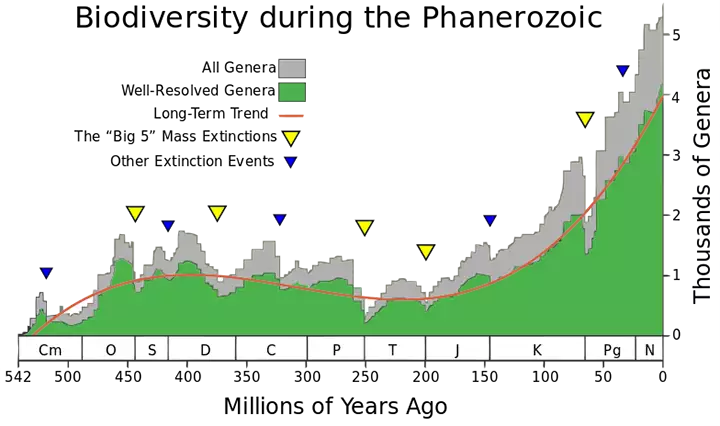
Biodiversity in the Phanerozoic Ages
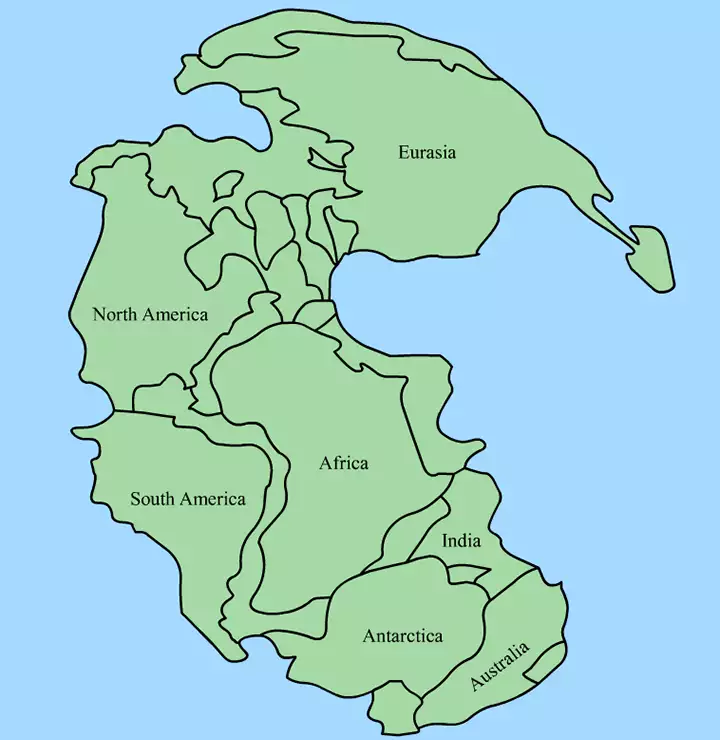
A map of today's continents at the time of Pangaea, c. 240 million years ago
Upper photo courtesy of Wikipedia userid Black Tusk, CCA 3.0 License
Lower graph is courtesy of Albert Mestre, CCA-by-SA 3.0 License
Laurentia map courtesy of the USGS
Photo of the Vredefort impact crater courtesy of NASA
Large map, basement rocks map and Geologic Clock are in the public domain
